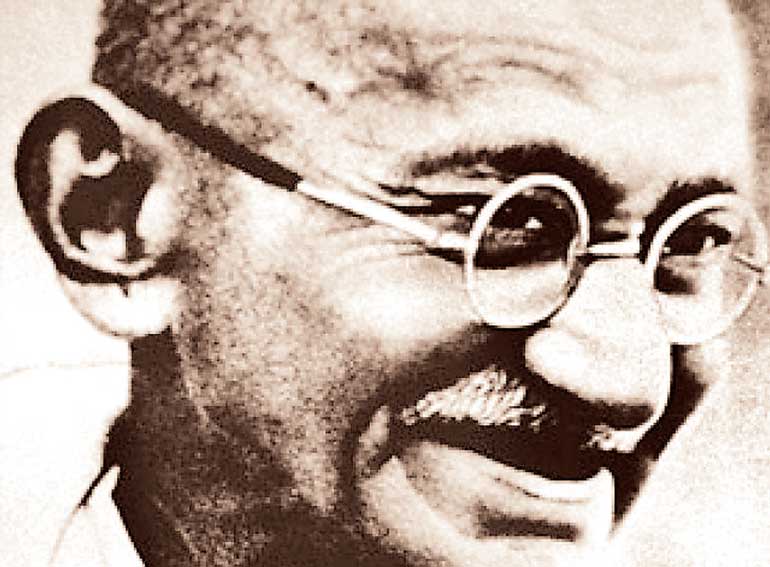Sunday Apr 20, 2025
Sunday Apr 20, 2025
Monday, 28 March 2016 00:00 - - {{hitsCtrl.values.hits}}

Gandhi became the epitome of a servant-leader by constantly heeding the counsel of those around him - AFP
It was a memorable occasion when the alumni of the PIM organised the first PIMA Olympics, a ceremony to recognise leaders.
Achievers in both the private and public sectors were felicitated, having been carefully chosen by an elite panel of judges led by Dr. Saman Kelegama. I, as the keynote speaker, reflected on the demanding concept of leadership. Today’s column revolves around leaders and laggards and the challenges of living with both of them.
Overview
Leadership is a much discussed topic in both private and public circles. According to R.M. Stogdill, a behavioral researcher, leadership is the most vastly researched and least understood phenomenon on earth. You may find the number of books on leadership in a management bookshelf easily outnumbering the rest. The point here is the vitality of leadership for organisational success. There is also an increasing demand for it.
Perhaps the only ship that survives a storm is leadership. It is not about positions and titles but about decisions and actions. Leadership is essentially a mindset. We look at the leaders at the top but not the “leaders at the tap”. The dynamics of leadership highlight the leaders and laggards in society, showcasing actions and inactions.
Leaders are performers. They practice what they preach. They inspire, influence and instruct in such a manner so as to initiate result-oriented action. In contrast, laggards are passengers. They hamper the progress by being lazy and lethargic. Indecisiveness resulting in inaction is often common in their approach.
Do we see more leaders or laggards? The answer lies in the results they achieve. Let me focus more on the business managers and public administrators leaving politicians aside. It is better to light a candle than curse the darkness. Living with leaders and laggards leaves with a fewer number of choices for achievement. Leaders have to be far more effective to overcome the ineffectiveness of laggards. My choice is to become a servant leader, in engaging laggards or even transforming them.
Leaders serve and laggards survive
Servant leadership is perhaps one of the most ancient forms of leadership, aptly found in all great religious founders. When you consider the 550 Jathaka stories, more than 50% of the time the Bodhisathva is portrayed as a leader, in some cases, as one who serves others. In brief, a servant leader is a servant first. The simple motto is service first.
 Jesus Christ washed the feet of his disciples and requested them to do the same with others. It is a true demonstration of servant leadership. There are instances from Prophet Mohamed’s life too where servant leadership characteristics are found.
Jesus Christ washed the feet of his disciples and requested them to do the same with others. It is a true demonstration of servant leadership. There are instances from Prophet Mohamed’s life too where servant leadership characteristics are found.
The fascinating point here is that the servant leader appears as a “leader breeder” in developing his/her followers to serve others. As in the case of several management concepts, the west “branded” servant leadership. Robert Greenleaf, a scholar from the US gets the credit for documenting the features and facets of servant leaders. Having worked for AT&T for several decades, he realised the limitations of typical administrative leaders. Having contemplated an alternative, the resulting model was the repackaged concept of servant leadership.
Let’s look at how he describes the concept further: “The servant-leader is servant first. Becoming a servant-leader begins with the natural feeling that one wants to serve, to serve first. Then conscious choice brings one to aspire to lead. That person is sharply different from one who is leader first. The difference manifests itself in the care taken by the servant first to make sure that other people’s highest priority needs are being served. The best test, and the most difficult to administer, is this: Do those served grow as persons? Do they, while being served, become healthier, wiser, freer, more autonomous, more likely themselves to become servants?”
Servant-leaders achieve results for their organisations by giving attention to the needs of their colleagues and those they serve. Servant-leaders are often seen as humble stewards of their organisation’s physical, financial and most importantly, human resources.
“Servant leadership is a blend and balance between leader and servant,” says Skip Prichard, who runs a centre on Servant Leadership. You don’t lose leadership qualities when becoming a servant leader. According to him, the following are the qualities of a servant leader: Values diverse opinions; cultivates a culture of trust; develops other leaders; helps people with life issues; encourages; sells instead of tells; thinks you, not me; thinks long-term and acts with humility.
There is no doubt that the above list is relevant to Sri Lankan business leaders. Special emphasis should be made on the final one. It reaffirms what Jim Collins, in his seminal book, ‘Good to Great’, mentioned about great leaders who have professional will and personal humility. Servant leaders do not get on to other’s shoulders but might carry others on their shoulders.
The opposite of the above is true for laggards. They struggle to survive and strive to stick to their status. Instead of serving others with a serene heart, they selfishly try to be served by others by seeking self-glorification.
Servant Leaders vs. subservient laggards
You can’t serve others without properly listening to them. A servant leader has the motivation to listen actively to his team and supports them in decision identification. This applies particularly to paying attention to the unspoken. This means relying on his/her inner voice and finding out what the body, mind and spirit are communicating.
Mahatma Gandhi did that with his fellow Indians. Managers need to do that with their teams. CEOs need to do that with their employees. In essence, servant leaders listen with care. As we discussed last week, Sri Lankan business leaders can improve their current level of listening to a much higher level.
A servant leader attempts to understand others and empathise with them. Workers may be considered not only employees but also people who need respect and appreciation for their personal development. Japanese business leaders have demonstrated this characteristic a lot in their typical approach to work. Here leadership is seen as a special type of human work, which ultimately generates a competitive advantage.
A great strength of a servant leader is the ability for healing one’s self and others. A servant leader tries to help people by solving their problems and conflicts in relationships because he/she wants to develop the capabilities of each individual. This leads to the formation of a business culture, in which the working environment is characterised by dynamism, fun and a lack of fear of failure.
Mother Teresa did this with destitute street children. HR professionals can demonstrate this in their coaching and counselling activities. Every manager can be a healer in such a manner that he/she strengthens inter-personal relationships.
A Servant Leader does not take advantage of his power and his status by forcing others to comply. He/she rather tries to convince them. This element distinguishes servant leadership most clearly from traditional, authoritarian models and can be traced back to the religious views of the inventor Robert Greenleaf.
This is one area where Sri Lankan managers can learn. Instead of forcing people to do things, convincing them of the benefits of doing particular things is what is needed.
Servant leadership is seen as an obligation to help and serve others. Openness and persuasion are more important than control. This reminds me of what Prime Minister S.W.R.D. Bandaranaike told the nation. The prime obligation of the man is to serve mankind. This offers fresh insights about our traditional leadership hierarchy. Instead of looking up to see how your boss is doing, you should look in front to see whether your customers are delighted or not.
Subservient laggards do the contrary. It is frustrating at times to see them in abundance in offices that are supposed to serve people. Seeking personal glory instead of serving the public has become a painful experience for many.
Way forward
Living with leaders and laggards is not comfortable. Yet it is the reality. Transforming laggards to leaders is not so easy. Yet it is necessary. Recognising and rewarding true leaders is one key step towards sending a clear message to laggards. Leadership development at all levels needs fresh thinking and focused action. The oft-quoted maxim echoes in my mind. “Those who serve deserve leadership.”
Discover Kapruka, the leading online shopping platform in Sri Lanka, where you can conveniently send Gifts and Flowers to your loved ones for any event including Valentine ’s Day. Explore a wide range of popular Shopping Categories on Kapruka, including Toys, Groceries, Electronics, Birthday Cakes, Fruits, Chocolates, Flower Bouquets, Clothing, Watches, Lingerie, Gift Sets and Jewellery. Also if you’re interested in selling with Kapruka, Partner Central by Kapruka is the best solution to start with. Moreover, through Kapruka Global Shop, you can also enjoy the convenience of purchasing products from renowned platforms like Amazon and eBay and have them delivered to Sri Lanka.
Discover Kapruka, the leading online shopping platform in Sri Lanka, where you can conveniently send Gifts and Flowers to your loved ones for any event including Valentine ’s Day. Explore a wide range of popular Shopping Categories on Kapruka, including Toys, Groceries, Electronics, Birthday Cakes, Fruits, Chocolates, Flower Bouquets, Clothing, Watches, Lingerie, Gift Sets and Jewellery. Also if you’re interested in selling with Kapruka, Partner Central by Kapruka is the best solution to start with. Moreover, through Kapruka Global Shop, you can also enjoy the convenience of purchasing products from renowned platforms like Amazon and eBay and have them delivered to Sri Lanka.